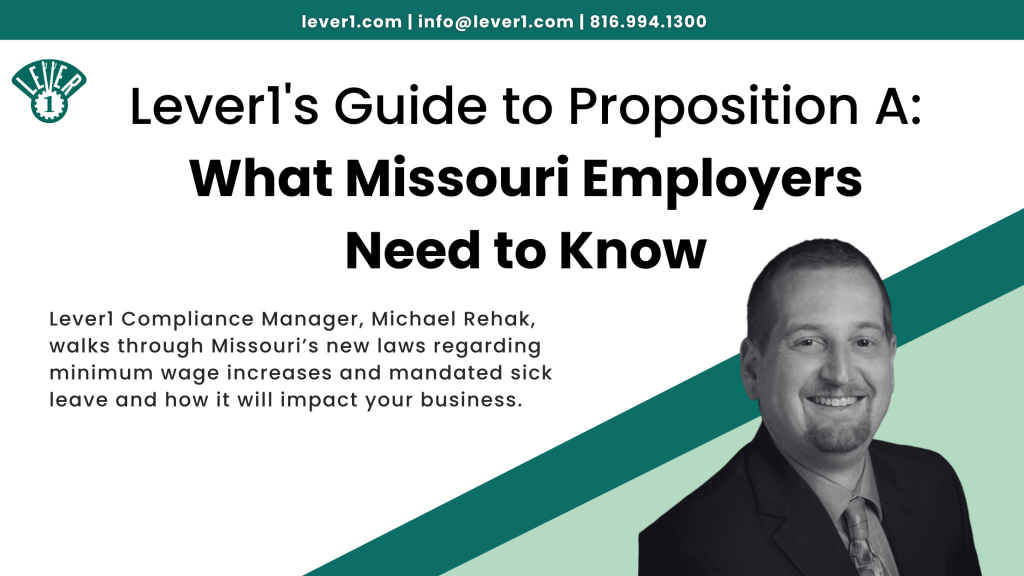
ATTENTION MISSOURI EMPLOYERS
Missouri voters recently passed Proposition A which affects Missouri employers across the state. Proposition A contained two different provisions that will become effective on January 1, 2025. The first of those provisions creates a stepped minimum wage increase. The second provision requires that employees are provided paid sick leave to be used throughout the year. These new laws are nuanced and contain multiple different deadlines. Lever1 is here to help you to navigate these changes and ensure compliance.
Minimum Wage Increases
The first provision of Proposition A amends the Missouri Minimum Wage law to provide for annual stepped increases in the minimum wage moving forward.
Starting on January 1, 2025, there will be a $1.25/hour increase in the Missouri minimum wage from $12.50/hour to $13.75/hour. Then on January 1, 2026, the minimum wage will be raised another $1.25/hour to $15.00/hour. After the January 2026 increase, the minimum wage will be tied to the consumer price index and will be adjusted accordingly every January 1, starting in January 2027.
Paid Sick Leave Policies
The second provision of Proposition A creates a paid sick leave requirement all employers will need to provide to employees. There are several aspects to this new law that employers should be mindful of to ensure that they are in compliance with the new leave requirements.
There are two deadlines that employers need to be aware of regarding paid sick leave. By April 15, 2025, employers must notify all employees in writing about the new paid sick leave benefits. Beginning May 1, 2025, the Paid Sick Leave policies must go into effect, and employees should begin accruing paid sick leave in accordance with the law.
All employees, including part-time employees, are entitled to 1 hour of paid sick leave for every 30 hours of work. Employers with paid leave policies equal to or in excess of this requirement are not required to provide additional leave under this law. All full-time exempt employees are considered to work 40 hours per week for accrual purposes.
The statue allows limits to the use of paid sick leave depending on the number of employees within a business. Employers with 15 or more employees can limit the use of paid sick leave to 56 hours per year but are allowed to set a higher limit. Employers with less than 15 employees can limit the use of paid sick leave to 40 hours per year, but again are allowed to set a higher limit. Employers cannot limit the use of paid sick leave below these set amounts.
All employees are entitled to carry over up to 80 hours of unused sick leave per year. Employers can choose not to allow the carryover of hours; however, the employer must pay out the employee for the unused hours at the end of the year. The employer must also provide an amount of sick time that meets or exceeds the requirements of the paid sick leave law for the employee to use at the beginning of the following year.
There are several other clauses in the law that help to clarify or provide guidance to employers and employees regarding the paid sick leave benefit. The law does not require the pay out of unused sick time upon resignation, termination, retirement, or any other form of separation of the employee. Employers are responsible for finding coverage for an employee out on paid sick leave and cannot require the employee to find coverage for their shift. The use of paid sick leave cannot lead to discipline, discharge, demotion, suspension or other adverse action. The employer can require reasonable documentation for absences of 3 or more consecutive workdays. Records of hours worked and sick time taken must be maintained by the employer for 3 years.
Managing compliance in a rapidly changing legal environment can be complex. Lever1 is here to help. Our HR and compliance experts provide guidance to keep business owners informed of new laws and policies, reducing your risk while saving you time.
Michael Rehak | Compliance Manager
As Compliance Manager for Lever1, Michael Rehak merges his legal expertise with practical business solutions. With a background in law, he navigates the complex regulatory landscape, ensuring clients’ are compliant with all regulations and laws. He works closely with clients offering tailored strategies to optimize compliance while maximizing operational efficiency. With a client-centric approach, he fosters strong relationships, earning trust as a reliable partner in navigating the ever-evolving regulatory environment.

